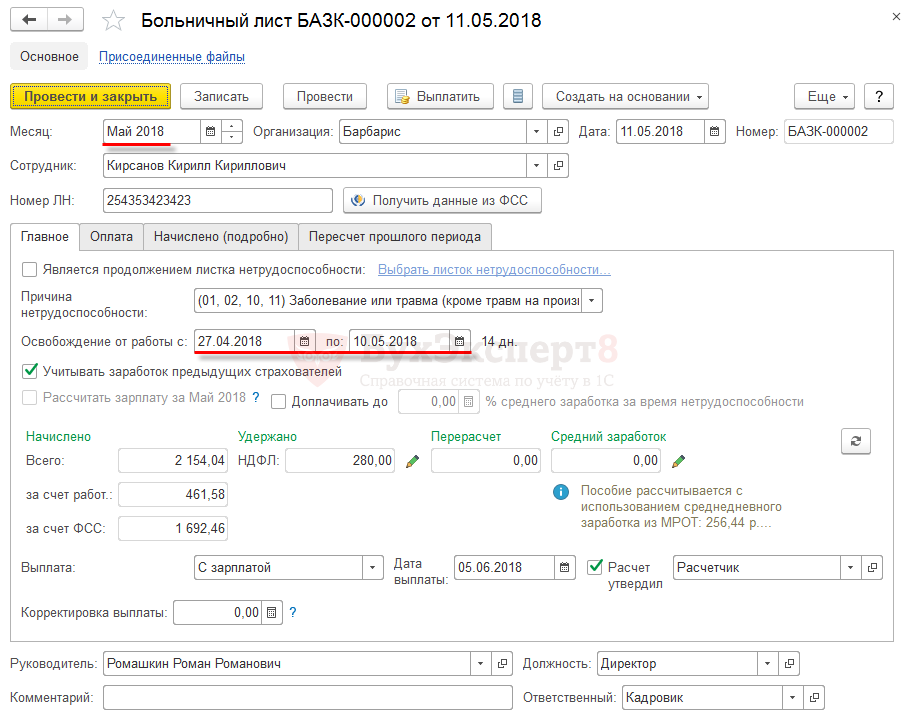If an employee was (or is still) “on sick leave” and has not yet provided the employer with a certificate of incapacity for work, but the time has come to calculate the salary or advance, then in order for him not to receive a salary for the period of “sick leave”, in the 1C program: ZUP 3 should be entered for an employee’s absence for an unknown reason. Let's look at how to correctly register absence for an unknown reason during the period of sick leave.
- Start
- Settings for registering absences for unknown reasons
- Registration of absence for an unknown reason
- Entering a document Absenteeism no-show
- Document approval Absenteeism no-show
- Reflection of absence for unknown reasons in the report card
- Actions after an employee submits sick leave
Start
Registration of absence for an unknown reason
Absence for an unknown reason is registered with the document Absenteeism, non-appearance (Human Resources – All absences of employees):
Entering the document “Absenteeism, no-show”
If two groups of users work with the program: HR specialists and payroll accountants, then it is assumed that the document Absenteeism, no-show is entered by a user with the HR , indicating the employee and the period of absence, and then the user with the Account Accountant approves the document.
In the document:
- in the Month , you should indicate the month for which absence should be taken into account when calculating wages;
- select the type of absence Absence for unknown reasons ;
- indicate the period of absence. If the end date of the period of absence is not yet known (the employee continues to be ill), then if the document is entered before calculating the advance, then the 15th day of the month is indicated, if before calculating the salary - the last day of the month.
Example 1
Gerankin G.G. fell ill on April 10 and notified the employer by telephone. By the time the advance payment for the first half of April was calculated, the employee had not yet returned to work and had not provided sick leave.
The fact of an employee’s absence is registered using the document Absenteeism, failure to appear .
The document should indicate the Month - April, since it is when calculating the advance payment for April that this absence should be taken into account.
In this case, the period of absence should be specified as the period from the 10th to the 15th, since the end date of the employee’s illness is not yet known, and the salary will be calculated for the first half of the month - from April 1st to April 15th, therefore, all absences must be reflected in the database that occurred on April 15th.

If in the example under consideration you do not return and provide a certificate of incapacity for work by the end of the month, then you will need to enter an absence for an unclear reason and for the period from April 16 to April 30, so that this absence will be taken into account in the final calculation of wages for April.
Example 2
Employee Kirsanov K.K. fell ill on April 27. By the time the salary for April was calculated (salaries are calculated on May 2), the employee had not yet returned and provided sick leave.
In this case, you also need to enter the document Absenteeism, failure to appear for this employee and register absence in April for an unknown reason for the period from April 27 to April 30.

It is important to select the correct Month in the document Absenteeism, no-show. If in the example discussed above you specify the Month is not April, but May, then when calculating the April salary, the program “will not see” the employee’s absence, and payment will be calculated for the month fully worked.
Approval of the document “Absenteeism, no-show”
After a user with the HR the document Absenteeism, Failure to Appear, it will be highlighted in bold in the document log, since it has not yet been approved. A user with the Account Accountant should approve the document using the Approve from Journal command or by checking the appropriate box in the document itself:

If multi-user work is not configured in the program, then the approval checkbox is not displayed in the document form; it is considered that the document is approved immediately when it is submitted.
After approval of the document Absenteeism, absence from attendance, when calculating the employee’s salary, the time worked will be determined taking into account this absence.
Example 1
After confirming the absence for an unknown reason, Gerankina G.G. during the period from April 10 to April 15, this absence will be taken into account when calculating the employee’s advance payment for April.

The employee works on a five-day, 36-hour workweek schedule and is paid by the day. In the period from April 1 to April 15, the employee’s schedule includes 10 working days, the employee worked 6 working days, not 10, since he was absent from April 10 to April 15.
The salary payment for the first half of April will be: 20,000 rubles: 21 working days (April norm) x 6 working days = 5,714.29 rubles.
Example 2
After confirming the absence for an unknown reason, Kirsanova K.K. during the period from April 27 to April 30, this absence will be taken into account when calculating salaries for April.
The employee works on a five-day schedule; the period from April 27 to April 30 accounts for 2 working days out of 21 normal days for April according to the employee’s schedule. Therefore, for Kirsanov, the calculation will occur only for 19 days worked:

The salary payment for April will be: 44,000 rubles. : 21 working days x 19 working days = 39,809, rub.
Fired for absenteeism?
Absenteeism is the absence of an employee from the workplace without good reason for more than four hours in a row or the entire working day (shift).
In the commented letter, officials addressed this situation.
During the period of remote work, the employee was urgently admitted to the hospital and could not immediately report this to his place of work. The opportunity to contact management appeared only after three days. At this time, the employer had already issued an order to dismiss him for absenteeism. Despite the situation and the employee’s obligation to provide a certificate from the hospital, the employer refused to change the decision to dismiss.
Does the employer have the right to do this?
Read in the berator “Practical Encyclopedia of an Accountant”
Gross violation of labor discipline
The main criterion for absenteeism is the absence of valid reasons for the employee’s absence from work. However, the Labor Code does not contain a list of reasons that are valid.
Therefore, in each specific case, the employer needs to determine whether the reason for the employee’s absence from the workplace is “valid.” It is impossible to fire an employee for absenteeism until the circumstances of his absence from work are clarified.
Why?
Actions after an employee submits “sick leave”
After the employee provides a certificate of incapacity for work, it is necessary to register the document Sick Leave . In this case, there is no need to somehow specifically reverse or delete the document Absenteeism, no-shows .
Example 1
On April 23, employee Gerankin G.G. returned to work and on April 27 provided the employer with a certificate of incapacity for work confirming his illness from April 10 to 20.
Based on the certificate of incapacity for work submitted by the employee, the program registered the document Sick Leave for the period from April 10 to April 20.

Days of absence for an unexplained reason ( UA ) are automatically superseded after registration in this period of sick leave ( B ). This can be seen in the report Timesheet (T-13) :

If sick leave is registered in the next month of accrual in relation to the document Absenteeism, failure to appear , then in the Sick Leave the absence for an unknown reason will be explicitly canceled.
Example 2
Employee Kirsanov K.K. I was sick from April 27 to May 10. On May 11, the employee returns to work and provides a certificate of incapacity for work.
By this time, the salary for April has already been calculated and paid. Sick leave for the period from April 27 to May 10 is registered in the accrual month of May:

A tab appears in the document Recalculation of the previous period , on which the cancellation of absence for an unknown reason is registered:

Did the article help?
Get another secret bonus and full access to the BukhExpert8 help system for 14 days free of charge
When is an employee’s absence considered absenteeism?
You will learn:
- What does the concept of “truancy” include and what are the measures to prevent losses from absenteeism
- How to correctly record an employee’s absence from work
- What measures can an employer take in relation to a truant worker?
In any organization, it happens that employees do not go to work. Sometimes, even if there are good reasons (for example, illness), the employee not only does not report his absence to the employer, but also does not confirm his absence from work with supporting documents. In this case, failure to appear is considered absenteeism.
But there are situations in which it is difficult to understand immediately: for a good reason, the employee stopped going to work or not, in which situations he can be fired, and in which - absolutely not. Often, a situation that is clear at first glance turns out to be far from being so simple upon further examination.
How to correctly assess the situation? What documents should be completed and within what time frame? How to prevent violations of labor laws? We will consider these and other questions in this article.
MEASURES TO PREVENT LOSSES FROM ABSENTANCE
The absence of an employee from work, even for a short time, disrupts the work process. To minimize damage, the organization must take a number of measures:
- The internal labor regulations must contain a clause obliging the employee to warn his immediate supervisor in advance about the inability to go to work, the reasons for absence and the expected period of absence. Fulfillment by the employee of the relevant obligations will help the manager make timely decisions on the distribution of the responsibilities of the absent employee among his colleagues;
- The head of a structural unit must have a list of employees whom he can entrust to perform the functions of an absent employee. The employees themselves, in turn, must be aware of the colleague’s affairs, which they will need to carry out in the event of his absence (not only unexpected, but also planned (for example, during a vacation or business trip));
- the manager must have specific instructions regulating his actions in the event of an employee’s absence without warning (example 1).
The instructions are of an auxiliary nature; they do not have to be issued on the organization’s letterhead and certified by the signature of the manager. The main condition is that they must contain a specific algorithm of actions.
Example 1
Memo to the head of the department on actions in case of employee absence
- Call the employee at all telephone numbers known to you (home, mobile, etc.) and find out the reason and possible duration of his absence.
- Ask your subordinates whether the employee has spoken about possible absence from work. If one of the employees is aware of the reasons for a colleague’s absence, ask them to state them in a memo addressed to the head of the organization.
- Draw up a report on the absence of the employee, the measures taken to find him and their results.
- Take all documents to the HR department and receive instructions there on further actions regarding the absent employee.
Specify in the documents as clearly as possible the employee’s workplace (workshop, machine, office number. If you have a chain of stores and regularly rotate staff, such specificity, on the one hand, will complicate the work of personnel services, increasing the document flow, and on the other hand, will protect the interests of the employer.
SCIENTIFIC EDITOR'S NOTE
A workplace is a place where an employee must be or arrive in connection with his work and which is directly or indirectly under the control of the employer. According to Part 4 of Art. 57 of the Labor Code of the Russian Federation, the condition of the employment contract about the workplace is an optional (that is, optional) clarification of the condition about the place of work. We recommend (if necessary) that the employee be assigned to a workplace not by an employment contract (in order to avoid subsequent problems with changing this condition of the employment contract), but by a unilateral document (an order for the organization, an order for the division, a notification, etc.).
When registering a part-time employee , focus his attention on the fact that part-time work (as opposed to freelancing) is carried out regularly , he is entitled to leave, as at his main place of work, but it is prohibited to go there without permission. As practice shows, many workers perceive part-time work as additional income if they have free time, not realizing that a second job involves the same obligations as when performing the main one.
THE EMPLOYEE DIDN'T GO TO WORK: WE FIX A NO-SEE
On the first day of an employee’s absence from work, we cannot be sure that he is absent (or even absent) and not sick.
A clear record of absence will help if the fact of absenteeism is confirmed over time, and will not hurt if the employee brings a certificate of incapacity for work . The failure to appear report must be drawn up in the presence of two witnesses. It is better if employees from related departments act in their capacity - if an employee challenges his dismissal in court, he will not be able to refer to the alleged pressure exerted on witnesses by the manager.
The Labor Code of the Russian Federation does not oblige the employer to immediately begin an active search. But if the missing employee is a responsible person, lives alone, and his phone does not answer, we recommend going to his home - perhaps the employee needs urgent help.
For example , dentist N. did not come to work on time. None of the colleagues heard the doctor planning to leave urgently or complaining about feeling unwell. The head of the department called him throughout the day, but the phone was silent. Concerned about N.'s absence, she went to his house. Nobody opened the door. When the local police officer was called and opened the apartment, it turned out that the 45-year-old man was dead (as it turned out, due to a stroke).
In the event of an employee’s absence from work, the letter code “NN” or the number 30 (failure to appear for unknown reasons (until the circumstances are clarified)) is entered in the work time sheet [1]. If the timesheet is maintained:
- manually, you can make notes with a pencil so that after finding out the reasons for the absence, you can write “B”, “T” or “PR” with a pen [2];
- using a computer, then all adjustments are printed after the circumstances of the absence have been clarified.
If the organization is large, with a complex structure, for uniformity of document flow, the procedure for recording working time in the absence of an employee should be clearly stated in the local regulatory act.
If you are not sure that the employee is sick, for the first week it makes sense to draw up reports of his absence every day; in the future, you can limit yourself to a report of the employee’s absence during the week, drawn up on Fridays. This issue is not regulated by law, so you need to be guided by common sense and judicial practice.
The legislation also does not establish a fixed list of documents that must be completed when absenteeism. In courts, most often accepted as evidence :
- time sheet with appropriate marks;
- acts or memos about the employee’s absence from the workplace;
SCIENTIFIC EDITOR'S NOTE
As well as certified printouts from the electronic system for recording the entry and exit of workers (paragraph 5 of clause 12 of the Resolution of the Plenum of the Supreme Court of the Russian Federation dated January 28, 2014 No. 1 “On the application of legislation regulating the work of women, persons with family responsibilities and minors”).
- notifications to the employee with a request to inform about the reasons for absence from work (Appeal ruling of the Moscow City Court dated August 2, 2013 No. 11-15221).
SCIENTIFIC EDITOR'S NOTE
In addition, if written explanations are not received from the employee, in accordance with Art. 193 of the Labor Code of the Russian Federation, an act of failure to provide explanations must be drawn up. In their practice, courts in most cases are of the opinion that the employer lawfully applied a disciplinary sanction, including dismissal for absenteeism, if the employee did not receive a notice to provide written explanations requested by telegram (or letter), for reasons beyond the control of the employer (Appeal ruling of the Moscow City Court dated July 28 .2014 No. 33-29793/14).
WE FIND OUT THE REASON FOR NO APPEARANCE
If an employee brings a certificate of incapacity for work or a certificate of seeing a doctor, all documents about his absence should be filed in the appropriate file. It is absolutely forbidden to destroy them !
If the employee does not present supporting documents, in accordance with Art. a written explanation from him . The Labor Code of the Russian Federation does not oblige the employer to draw up a request (notification) in writing (example 2 ® ), but in court, a document is always a more powerful argument than words. Therefore, it is better to make a request in two copies, give one to the employee, and ask him to sign on the second.
Example 2
Notice of the need to explain the reasons for non-appearance
If the employee does not provide written explanations within two working days, a corresponding report should be drawn up.
Failure by an employee to provide explanations is not an obstacle to applying a disciplinary sanction (including dismissal) (Part 2 of Article 193 of the Labor Code of the Russian Federation).
If an employee does not come to work for a month or more and does not answer phone calls, the search should be intensified. You can call him at home after work - there is a high probability that his loved ones (and perhaps the employee himself) will be able to clarify the situation. Since it is difficult to attract witnesses to a telephone conversation in the evening, try to record the conversation on a voice recorder, and state the results of the call the next day in a memo addressed to the manager. Recording a telephone conversation in itself is not sufficient grounds for dismissal for absenteeism, but will be additional evidence that the employer is right.
It is also necessary to send registered letters with acknowledgment of receipt to all known addresses where the employee may be, with a requirement to explain the reasons for non-appearance in writing within 2 days, and if this is not possible, contact the HR department or immediate supervisor by phone.
SCIENTIFIC EDITOR'S NOTE
It is better if the letters are valuable with an inventory of the contents (to exclude speculation on the part of the employee) and, of course, with a receipt.
WHAT IS CONSIDERED A SHALKING?
Dictionary
Absenteeism is absence from the workplace without good reason during the entire working day (shift), regardless of its duration, as well as absence from the workplace without good reason for more than four hours in a row during the working day (shift) (sub. " a" clause 6, part 1, article 81 of the Labor Code of the Russian Federation).
There is no exhaustive list of valid reasons for an employee’s absence from work. To assess an offense, one should be guided by judicial practice:
1. the following to be valid reasons for absence from work:
- visiting a lawyer to get advice on violation of labor rights (Decree of the Moscow Regional Court dated November 24, 2011 in case No. 33-26558);
- being on leave without pay when the employee is entitled to such leave by law in accordance with Part 2 of Art. 128 of the Labor Code of the Russian Federation (Appeal ruling of the Kemerovo Regional Court dated August 17, 2012 in case No. 33-7790);
- illness of the employee, including in the absence of a certificate of incapacity for work (Appeal ruling of the Supreme Court of the Republic of Mordovia dated February 21, 2013 in case No. 33-426/2013);
SCIENTIFIC EDITOR'S NOTE
Let us note that there is also opposite judicial practice, for example, Ruling of the Chelyabinsk Regional Court dated July 10, 2014 No. 11-7179/2014 recognizing the abuse of the right of an employee not notifying the employer of his temporary disability and the absence in this case of obstacles to the dismissal of an employee at the initiative of the employer.
- fire, short circuit, emergencies, natural disasters (Appeal ruling of the Khabarovsk Regional Court dated March 1, 2013 in case No. 33-1372/2013).
2. as disrespectful reasons :
- unauthorized termination of work before the expiration of the employment contract (Article 79 of the Labor Code of the Russian Federation) or notice of dismissal (Part 1 of Article 80, Article 280, Part 1 of Article 292 and Part 1 of Article 296 of the Labor Code of the Russian Federation);
- unauthorized use of days off or unauthorized going on vacation (subparagraph “d”, paragraph 39 of the Resolution of the Plenum of the Supreme Court of the Russian Federation dated March 17, 2004 No. 2 “On the application by the courts of the Russian Federation of the Labor Code of the Russian Federation” (as amended on September 28, 2010).
The above lists are not exhaustive - it is impossible to foresee all life situations, but by focusing on them, you will be able to more objectively assess the degree of guilt of the employee.
HOW TO DEAL WITH A SHUTTER
According to the Labor Code of the Russian Federation, the employer has the right to dismiss an employee for absenteeism (subparagraph “a”, paragraph 6, part 1, article 81 of the Labor Code of the Russian Federation), but is not necessarily obliged to do this. Moreover, in accordance with Part 5 of Art. 192 of the Labor Code of the Russian Federation, when imposing a disciplinary sanction, the severity of the offense committed and the circumstances under which it was committed must be taken into account.
Regardless of the penalty applied, it is necessary to strictly observe the procedure prescribed in Art. 193 Labor Code of the Russian Federation.
Extraction
from the Labor Code of the Russian Federation
Article 193. Procedure for applying disciplinary sanctions
Before imposing disciplinary action, the employer must request a written explanation from the employee. If after two working days the employee does not provide the specified explanation, then a corresponding act is drawn up.
Failure by an employee to provide an explanation is not an obstacle to applying disciplinary action.
Disciplinary action is applied no later than one month from the date of discovery of the misconduct, not counting the time of illness of the employee, his stay on vacation, as well as the time necessary to take into account the opinion of the representative body of employees.
A disciplinary sanction cannot be applied later than six months from the date of commission of the offense, and based on the results of an audit, inspection of financial and economic activities or an audit - later than two years from the date of its commission. The specified time limits do not include the time of criminal proceedings.
For each disciplinary offense, only one disciplinary sanction can be applied.
The employer's order (instruction) to apply a disciplinary sanction is announced to the employee against signature within three working days from the date of its publication, not counting the time the employee is absent from work. If the employee refuses to familiarize himself with the specified order (instruction) against signature, then a corresponding act is drawn up.
A disciplinary sanction can be appealed by an employee to the state labor inspectorate and (or) bodies for the consideration of individual labor disputes.
ADVICE
If you are not sure that the employee is absent without good reason, we recommend periodically calling him in the presence of witnesses, drawing up reports on the results of negotiations, and periodically (for example, once a month) sending registered letters demanding an explanation for his absences.
If the employee is actually absenteeism, you should write a memo addressed to the head of the organization detailing all the circumstances that qualify the employee’s absence as absenteeism, and attach to it all available documents (absence certificates, notifications of delivery of registered letters or returned letters, employee memos , clarifying the circumstances of non-appearance, etc.). These documents are the grounds for dismissing an employee for absenteeism, and all of them must be listed in the dismissal order. The date of dismissal of the employee will be the date the head of the organization signs the order to dismiss the absentee (Parts 3 and 6 of Article 84.1 of the Labor Code of the Russian Federation). In the order (as in the work book and personal card), the entry about the reason and basis for dismissal must exactly repeat the wording set out in the Labor Code of the Russian Federation (“dismissed/dismissed for absenteeism”).
The situation with missing workers is ambiguous:
- A notice of delivery of a registered letter containing a requirement to explain the failure to appear has been received, but the employee has not contacted him - an appropriate act must be drawn up [3], after which the employee can be fired for absenteeism.
- The same should be done if the letter was returned due to the addressee’s refusal to receive it. The legitimacy of this point of view is supported by the courts (Appeal ruling of the Ulyanovsk Regional Court dated July 15, 2014 No. 33-2339/2014).
- The employee’s letter was returned due to the expiration of the storage period - it is necessary to try to find out the reasons why the employee did not receive it. If the employee was unable to receive the letter due to illness, his dismissal will be illegal. And if he decided to abuse his right and thus refuse to give explanations, then, according to Part 2 of Art. 193 of the Labor Code of the Russian Federation, failure to receive a letter cannot serve as an obstacle to dismissal.
NOTE
It is prohibited to fire pregnant women, even if the fact of absenteeism is confirmed!
THE EMPLOYEE IS FIRED. WHAT'S NEXT?
Part 2 Art. 84.1 of the Labor Code of the Russian Federation obliges the employer to familiarize the employee with the dismissal order against signature, and part 4 of the same article - to issue a work book on the day of dismissal.
According to Part 6 of Art. 84.1 of the Labor Code of the Russian Federation, if an employee is fired for absenteeism[4], the employer is relieved of responsibility for storing the work book, but there is an obligation to issue it no later than three days from the date of receipt of the employee’s written request.
On the dismissal order, a note should be made about the impossibility of bringing its contents to the attention of the employee due to his absence from work (Part 2 of Article 84.1 of the Labor Code of the Russian Federation). We recommend making a similar entry in your personal card.
Regardless of the grounds for dismissal, on the day of dismissal you must make a full settlement with the employee: pay all due wages, as well as compensation for unused vacation. If the employee does not have a bank card, the accrued amounts are deposited.
Strict adherence to all the measures described in this article will help you avoid mistakes when parting with truants and prove your case in court.
Conclusions:
- A clear record of absence will help if the fact of absenteeism is confirmed over time, and will not hurt if the employee brings a certificate of incapacity for work.
- Failure by an employee to provide explanations is not an obstacle to applying disciplinary action. When imposing a disciplinary sanction, the severity of the offense committed and the circumstances under which it was committed must be taken into account.
- Regardless of the penalty applied, it is necessary to strictly observe the procedure prescribed in Art. 193 Labor Code of the Russian Federation.
[1] If your organization has not introduced its own designations that differ from the generally accepted ones.
[2] Accordingly: temporary disability with benefits, temporary disability without pay or absenteeism.
[3] Act on failure to provide explanations (Part 1 of Article 193 of the Labor Code of the Russian Federation) - Note. scientific editor.
[4] Accordingly, there is no need to send an employee fired for absenteeism a notice of the need to pick up his work book - Note. scientific editor.










